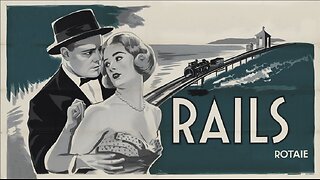Premium Only Content

INGAGI (1930) Sir Hubert Winsead, Charles Gemora and Arthur Clayton | Action / Adventure | B&W
Ingagi is a 1930 pre-Code mockumentary exploitation film directed by William S. Campbell. It purports to be a documentary about "Sir Hubert Winstead" of London on an expedition to the Belgian Congo, and depicts a tribe of gorilla-worshipping women encountered by the explorer. The film claims to show a ritual in which African women are given over to gorillas as sex slaves, but in actuality was mostly filmed in Los Angeles, using American actresses in place of natives. It was produced and distributed by Nat Spitzer's Congo Pictures, which had been formed expressly for this production. Although marketed under the pretense of being ethnographic, the premise was a fabrication, leading the Motion Picture Producers and Distributors Association to retract any involvement.
SYNOPSIS
An expedition enters an area of the Congo jungle to investigate reports of a gorilla-worshipping tribe. After many dangerous adventures, they come upon the tribe they sought, only to watch as a virgin is sacrificed to a huge gorilla, who takes her away. The expedition follows the gorilla in an attempt to save the woman.
CAST & CREW
Sir Hubert Winstead as Explorer
Charles Gemora as Ingagi - The Gorilla (uncredited)
Arthur Clayton as Daniel Swayne
Louis Nizor as Narrator
Directed by William S. Campbell
Written by Adam Shirk
Produced by William D. Alexander, Nat Spitzer
Cinematography L. Gillingham
Music by Edward Gage
Production company Congo Pictures
Distributed by Congo Pictures
Release date: March 15, 1930
Running time: 75 minutes
Country: United States
Language: English
Box office: $4 million
NOTES
The film trades heavily on its nudity and on the suggestion of sex between a woman and a gorilla. Its success motivated RKO Radio Pictures to invest in the 1933 film, King Kong.[citation needed] RKO owned several of the theatres where Ingagi was shown, including one of the first, the Orpheum Theatre in San Francisco, where it opened April 5, 1930.
Much of the footage featured in the film was taken without permission from Grace Mackenzie's 1915 film Heart of Africa, which later resulted in legal action being brought against Congo Pictures by Mackenzie's son. The film purports to feature footage of a newly discovered animal, the "Tortadillo", however this animal was in fact a turtle with false wings and scales attached to it. The majority of the original footage was filmed at the Griffith Park Zoo.
The gorilla in the film is portrayed with a mixture of stock footage, much of which is actually footage of orangutans and chimpanzees, and actors in gorilla costumes. In October 1930, actor Charlie Gemora signed an affidavit swearing that he portrayed the gorilla. Actor Hilton Phillips, originally hired to play one of the African natives in the film, alleged that he also played the gorilla. Phillips later sued Congo Pictures, claiming they failed to pay him.
It was reported that Congo Pictures prepared versions of Ingagi dubbed in French, German, and Spanish. Sources have claimed that the word "ingagi" cannot be found "in any African language dictionary". "Ingagi" is in fact a Kinyarwanda word meaning "gorilla".
Following the film's release, multiple articles and reviews were published that were skeptical of the film's authenticity. In response, Congo Pictures filed a lawsuit against the MPPDA seeking $3,365,000 in damages, claiming that the MPPDA had "circulated reports doubting the authenticity of the film".
An investigation by the Federal Trade Commission concluded that the majority of the film was "false, fraudulent, deceptive and misleading", and ordered Congo Pictures to withdraw any advertising and material from the film proclaiming it to be genuine. As a result, the film was pulled from circulation. The Federal Trade Commission removed its sanction on the film in 1947.
The film was never lost, contrary to popular belief due to it long being unavailable on home video or television. Three nitrate prints are held at The Library of Congress.
Seven of the eight Vitaphone discs have been found by fans and are now available on YouTube 96 seconds of the film are included in the documentary Charlie Gemora: Uncredited.
In partnership with Something Weird Video, Kino Classics released a 4K restoration of the film on Blu-ray Disc on January 5, 2021
Congo Pictures followed Ingagi with an unsuccessful film titled Nu-Ma-Pu - Cannibalism in 1931, featuring much of the same crew. Like Ingagi, it purported to be a documentary, but was mostly fictitious.
The 1937 film Love Life of a Gorilla likely borrows footage from Ingagi, as contemporary plot descriptions mention a character named "Colonel Hubert Winstead".
-
 1:08:30
1:08:30
Lost n Found Films
1 day agoRAILS (1929) Käthe von Nagy, Maurizio D’Ancora & Daniele Crespi | Drama | Nostalgic Flick
89 -
 LIVE
LIVE
BlackDiamondGunsandGear
3 hours agoAre ALL Striker Fired Pistols UNSAFE? // After Hours Armory
1,053 watching -
 6:34:50
6:34:50
SpartakusLIVE
7 hours ago#1 Saturday Spartoons on RUMBLE PREMIUM
96.6K6 -
 1:04:59
1:04:59
Man in America
8 hours ago“Summoning the Demon” — The AI Agenda Is FAR WORSE Than We Know w/ Kay Rubacek
26.8K20 -
 2:16:48
2:16:48
Tundra Tactical
6 hours ago $0.06 earned🎯💥 The World’s Okayest Gun Show 🔫😂 | LIVE Tonight on Rumble!
15.6K -
 3:36:03
3:36:03
Mally_Mouse
1 day ago🌶️ 🥵Spicy BITE Saturday!! 🥵🌶️- Let's Play: Tower Unite!
37.2K1 -
 58:59
58:59
MattMorseTV
6 hours ago $1.12 earned🔴Trump just BROKE Newsom.🔴
55K60 -
 18:14
18:14
Her Patriot Voice
6 hours agoWho Is WORSE for NYC: Trump Girl or Socialist?
32K27 -
 3:39:42
3:39:42
SavageJayGatsby
5 hours agoSpicy Saturday with Mally! | Road to 100 | $300 Weekly Goal for Spicy Bites!
36.5K1 -
 3:35:50
3:35:50
FomoTV
7 hours ago🚨 Swamp Theater: FBI Raids Bolton 🕵 Still NO Epstein Files, Trump's Troops & the Red Heifer Hoax 🐂 | Fomocast 08.23.25
14.6K3